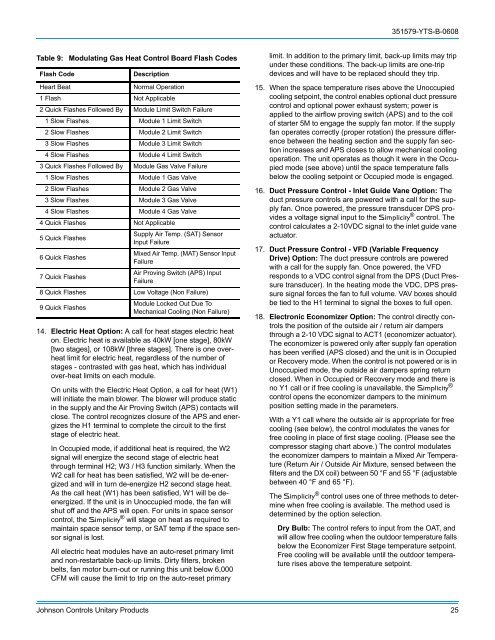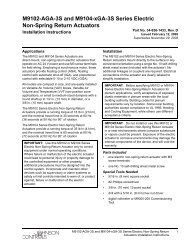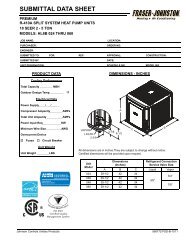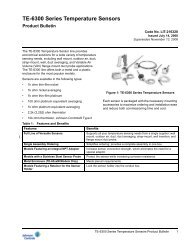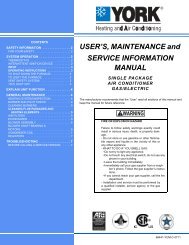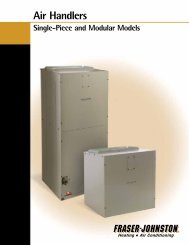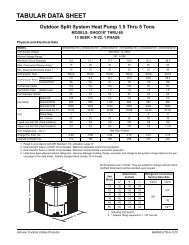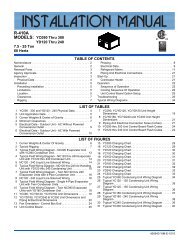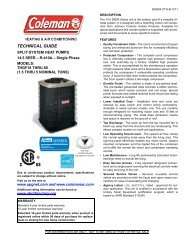analog to digital converter . . . . . . . . . . . . . . . 4 - UPGNet
analog to digital converter . . . . . . . . . . . . . . . 4 - UPGNet
analog to digital converter . . . . . . . . . . . . . . . 4 - UPGNet
Create successful ePaper yourself
Turn your PDF publications into a flip-book with our unique Google optimized e-Paper software.
351579-YTS-B-0608Table 9: Modulating Gas Heat Control Board Flash CodesFlash CodeDescriptionHeart BeatNormal Operation1 Flash Not Applicable2 Quick Flashes Followed By Module Limit Switch Failure1 Slow Flashes Module 1 Limit Switch2 Slow Flashes Module 2 Limit Switch3 Slow Flashes Module 3 Limit Switch4 Slow Flashes Module 4 Limit Switch3 Quick Flashes Followed By Module Gas Valve Failure1 Slow Flashes Module 1 Gas Valve2 Slow Flashes Module 2 Gas Valve3 Slow Flashes Module 3 Gas Valve4 Slow Flashes Module 4 Gas Valve4 Quick Flashes Not Applicable5 Quick Flashes6 Quick FlashesSupply Air Temp. (SAT) SensorInput FailureMixed Air Temp. (MAT) Sensor InputFailure7 Quick FlashesAir Proving Switch (APS) InputFailure8 Quick Flashes Low Voltage (Non Failure)9 Quick FlashesModule Locked Out Due ToMechanical Cooling (Non Failure)14. Electric Heat Option: A call for heat stages electric hea<strong>to</strong>n. Electric heat is available as 40kW [one stage], 80kW[two stages], or 108kW [three stages]. There is one overheatlimit for electric heat, regardless of the number ofstages - contrasted with gas heat, which has individualover-heat limits on each module.On units with the Electric Heat Option, a call for heat (W1)will initiate the main blower. The blower will produce staticin the supply and the Air Proving Switch (APS) contacts willclose. The control recognizes closure of the APS and energizesthe H1 terminal <strong>to</strong> complete the circuit <strong>to</strong> the firststage of electric heat.In Occupied mode, if additional heat is required, the W2signal will energize the second stage of electric heatthrough terminal H2; W3 / H3 function similarly. When theW2 call for heat has been satisfied, W2 will be de-energizedand will in turn de-energize H2 second stage heat.As the call heat (W1) has been satisfied, W1 will be deenergized.If the unit is in Unoccupied mode, the fan willshut off and the APS will open. For units in space sensorcontrol, the Simplicity ® will stage on heat as required <strong>to</strong>maintain space sensor temp, or SAT temp if the space sensorsignal is lost.All electric heat modules have an au<strong>to</strong>-reset primary limitand non-restartable back-up limits. Dirty filters, brokenbelts, fan mo<strong>to</strong>r burn-out or running this unit below 6,000CFM will cause the limit <strong>to</strong> trip on the au<strong>to</strong>-reset primarylimit. In addition <strong>to</strong> the primary limit, back-up limits may tripunder these conditions. The back-up limits are one-tripdevices and will have <strong>to</strong> be replaced should they trip.15. When the space temperature rises above the Unoccupiedcooling setpoint, the control enables optional duct pressurecontrol and optional power exhaust system; power isapplied <strong>to</strong> the airflow proving switch (APS) and <strong>to</strong> the coilof starter 5M <strong>to</strong> engage the supply fan mo<strong>to</strong>r. If the supplyfan operates correctly (proper rotation) the pressure differencebetween the heating section and the supply fan sectionincreases and APS closes <strong>to</strong> allow mechanical coolingoperation. The unit operates as though it were in the Occupiedmode (see above) until the space temperature fallsbelow the cooling setpoint or Occupied mode is engaged.16. Duct Pressure Control - Inlet Guide Vane Option: Theduct pressure controls are powered with a call for the supplyfan. Once powered, the pressure transducer DPS providesa voltage signal input <strong>to</strong> the Simplicity ® control. Thecontrol calculates a 2-10VDC signal <strong>to</strong> the inlet guide vaneactua<strong>to</strong>r.17. Duct Pressure Control - VFD (Variable FrequencyDrive) Option: The duct pressure controls are poweredwith a call for the supply fan. Once powered, the VFDresponds <strong>to</strong> a VDC control signal from the DPS (Duct Pressuretransducer). In the heating mode the VDC, DPS pressuresignal forces the fan <strong>to</strong> full volume. VAV boxes shouldbe tied <strong>to</strong> the H1 terminal <strong>to</strong> signal the boxes <strong>to</strong> full open.18. Electronic Economizer Option: The control directly controlsthe position of the outside air / return air dampersthrough a 2-10 VDC signal <strong>to</strong> ACT1 (economizer actua<strong>to</strong>r).The economizer is powered only after supply fan operationhas been verified (APS closed) and the unit is in Occupiedor Recovery mode. When the control is not powered or is inUnoccupied mode, the outside air dampers spring returnclosed. When in Occupied or Recovery mode and there isno Y1 call or if free cooling is unavailable, the Simplicity ®control opens the economizer dampers <strong>to</strong> the minimumposition setting made in the parameters.With a Y1 call where the outside air is appropriate for freecooling (see below), the control modulates the vanes forfree cooling in place of first stage cooling. (Please see thecompressor staging chart above.) The control modulatesthe economizer dampers <strong>to</strong> maintain a Mixed Air Temperature(Return Air / Outside Air Mixture, sensed between thefilters and the DX coil) between 50 °F and 55 °F (adjustablebetween 40 °F and 65 °F).The Simplicity ® control uses one of three methods <strong>to</strong> determinewhen free cooling is available. The method used isdetermined by the option selection.Dry Bulb: The control refers <strong>to</strong> input from the OAT, andwill allow free cooling when the outdoor temperature fallsbelow the Economizer First Stage temperature setpoint.Free cooling will be available until the outdoor temperaturerises above the temperature setpoint.Johnson Controls Unitary Products 25


